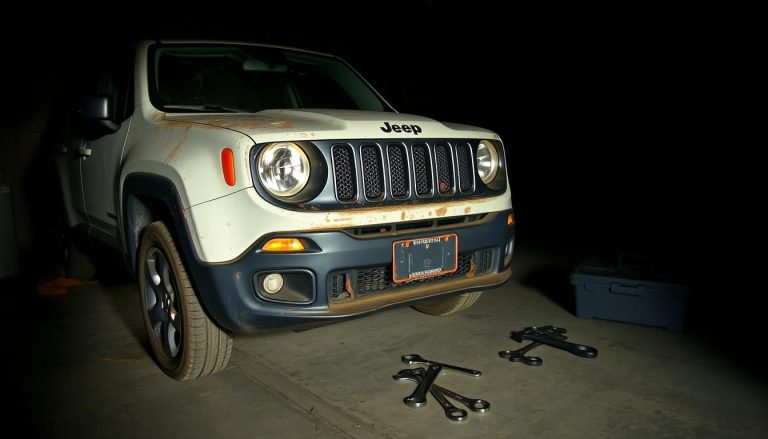Jeep Check Engine Light – Causes & Fixes
The Jeep check engine light is a key warning that tells you something’s wrong with your vehicle. It could be a small issue or a big problem. Knowing what to do can help keep your Jeep running well.
It might just need a tight gas cap or a more serious fix like a new catalytic converter. Quick action can stop bigger problems and keep your Jeep in top shape.
This article will guide you through the jeep check engine light. You’ll learn about common problems, how to fix them, and how to avoid them. Stay ready to handle any issue and keep your Jeep safe and efficient.
The Jeep Check Engine Light
The check engine light in your Jeep is a key indicator of your vehicle’s health. It’s part of the onboard diagnostics (OBD) system. This system checks various engine parts to make sure they work right. Knowing what the light means helps you take the right steps.
What the Light Means
The symptoms of a jeep check engine light can vary. A steady light usually means a less serious problem. Issues like a loose gas cap or minor engine problems are common. But, it’s important not to ignore it.
Keeping your Jeep in top shape is key. Fixing these warnings early can stop bigger problems later.
Solid vs. Flashing Check Engine Light
It’s important to know the difference between a steady and flashing check engine light. A flashing light means a serious issue that needs quick action. Ignoring it could cause big engine damage or even a complete failure.
These meanings and acting fast is vital. It helps keep your vehicle running well for a long time.
Common Causes of a Jeep Check Engine Light
Seeing the check engine light on your Jeep’s dashboard can worry you. Knowing the usual reasons can help you find and fix the problem quickly.
Loose Gas Cap
A loose or missing gas cap is a common cause. It can cause fuel vapor to leak, lowering system pressure. Always tighten your gas cap after filling up.
Failing Catalytic Converter
A failing catalytic converter is another common problem. It helps make exhaust gases less harmful. If it fails, it can hurt your Jeep’s performance and fuel use. Fixing this issue quickly is important.
Faulty Oxygen Sensor
The oxygen sensor checks the air-fuel mix in your Jeep. A bad sensor sends wrong data, messing with fuel burning. This can turn on the check engine light, lower fuel efficiency, and increase emissions.
Mass Airflow Sensor Issues
Mass airflow (MAF) sensor problems are also common. It measures air intake. Issues with it can upset the air-fuel mix, hurting engine performance and turning on the check engine light. Keeping this sensor in good shape helps avoid problems.
Knowing these common causes helps Jeep owners take care of their vehicles better. Fixing these issues quickly can make your Jeep run smoother and last longer.
Troubleshooting Your Jeep Check Engine Light
When your Jeep’s check engine light comes on, it’s important to find out why. Using the right tools and methods can help a lot. An OBD2 scanner is great for reading jeep check engine codes. Also, a visual inspection can show you obvious problems.
Using an OBD2 Scanner
An OBD2 scanner is key for fixing your Jeep’s engine light. It plugs into your Jeep’s onboard diagnostics port, usually under the dashboard. Here’s how to use it:
- Connect the Scanner: Plug the OBD2 scanner into the diagnostic port.
- Turn On the Ignition: Switch the ignition to the “ON” position without starting the engine.
- Read the Codes: Follow the scanner instructions to read the jeep check engine codes.
- Interpret the Codes: Use the code definitions provided by the scanner to understand the specific issues.
By following these steps, you can accurately identify the problem indicated by your Jeep’s check engine light.
Inspecting for Visible Issues
It’s also important to do a visual check of your vehicle. This hands-on approach can help you spot visible problems. Here are some key areas to inspect:
- Hoses and Cables: Check for disconnected or damaged hoses and cables.
- Engine Components: Look for signs of wear or damage on engine components.
- Fluid Levels: Ensure all fluid levels are within the recommended range.
- Battery Connections: Check for corrosion or loose connections on the battery terminals.
Using an OBD2 scanner and doing a visual inspection together helps a lot. This way, you can find and fix the problem better.
Jeep Check Engine Codes Explained
When your Jeep’s check engine light comes on, it’s a serious warning. It means your vehicle’s onboard diagnostics system has detected a problem. This light is often paired with a diagnostic trouble code (DTC), which gives specific details about the issue. Knowing these codes is key to fixing your Jeep right.
Common Error Codes
Jeep owners often see a few common error codes. Each code signals a specific problem, like issues with emissions, engine performance, or electrical systems. Let’s take a closer look at some important ones:
- P0171: System Too Lean (Bank 1)
- P0300: Random/Multiple Cylinder Misfire Detected
- P0420: Catalyst System Efficiency Below Threshold (Bank 1)
- P0442: Evaporative Emission System Leak Detected (small leak)
- P0456: Evaporative Emission System Leak Detected (very small leak)
What Each Code Means
It’s important to understand what each diagnostic trouble code (DTC) means. This helps you troubleshoot jeep engine light issues effectively.
- P0171: Shows a lean condition, meaning too much air and not enough fuel. This is often due to intake manifold leaks or faulty fuel injectors.
- P0300: Indicates a misfire in multiple cylinders. This is usually caused by ignition system issues or fuel delivery problems.
- P0420: Points to a problem with the catalytic converter’s efficiency. This might need a replacement to ensure proper emission control.
- P0442: Suggests a small leak in the evaporative emission control system. This could be due to a loose gas cap or damaged EVAP hoses.
- P0456: Denotes a very small leak in the EVAP system. Similar to P0442, checking the gas cap and hoses is a good starting point.
Accurately diagnosing and addressing these error codes makes fixing your Jeep’s check engine light easier. What these codes mean, you can target repairs more precisely.
When dealing with jeep engine light issues, always check your Jeep’s service manual. Or, consult with a professional mechanic to ensure the correct interpretation and fix.
Immediate Actions to Take When Your Check Engine Light Comes On
When the check engine light in your Jeep lights up, it demands immediate attention to prevent damage. First, check if the gas cap is loose. A loose gas cap can often trigger the check engine light due to vapor leaks in the fuel system.
Next, monitor your vehicle’s performance for any unusual behavior. Look out for misfires, stalling, or a decrease in power. If you have an OBD2 scanner, use it to read any error codes. This can help identify specific issues and streamline the process to fix jeep check engine light.
If the jeep check engine light is blinking, it signifies a more severe problem. This is usually related to engine misfiring, which could harm your catalytic converter. In such cases, it’s advised to pull over safely and seek professional assistance immediately.
How to Reset the Jeep Check Engine Light
Resetting the jeep check engine light reset has several methods. You can do it yourself or get help from a pro. This guide will help you get your Jeep running smoothly again.
Manual Reset Methods
Resetting the jeep check engine light manually is easy. One way is to disconnect the battery for a few minutes. This clears temporary error codes from the computer.
- Turn off the ignition and open the hood.
- Disconnect the negative battery terminal using a wrench.
- Wait for about 15 minutes to ensure all residual power drains from the system.
- Reconnect the battery terminal and tighten the clamp.
- Start the Jeep and check if the check engine light has reset.
This method works for temporary errors. But, if the light comes back on soon, it might mean a bigger problem. You might need a pro to figure it out.
Professional Reset Services
For ongoing or tricky issues, get professional help. Certified mechanics have the tools to find and fix the problem.
- OBD2 Scanners: Mechanics use an OBD2 scanner to read error codes and reset the light.
- Comprehensive Diagnostics: They do a detailed check to see if parts need fixing or replacing.
- Software Updates: Sometimes, updating the software can fix system glitches.
Getting a pro ensures the real problem is fixed. This helps avoid future problems with your Jeep.
When to Seek Professional Help for Your Jeep’s Engine Light
Dealing with a check engine light in your Jeep can be tough. Knowing when to get help is key. Spotting serious problems early can prevent costly fixes and keep your Jeep running well.
Signs You Should Not Ignore
Some symptoms mean you should get a pro to check your Jeep’s engine light. Here are the signs you can’t ignore:
- Flashing Check Engine Light: A flashing light is a big warning. It means a serious issue, like a misfire, that could harm your catalytic converter if not fixed fast.
- Reduced Vehicle Performance: If your Jeep is slow to start, stalls, or uses more gas, it could have big engine or transmission problems.
- Strange Noises or Smells: Odd sounds from the engine or weird smells, like burning or sulfur, need quick attention to avoid more damage.
Choosing the Right Mechanic
Finding the right mechanic is critical when your Jeep’s check engine light comes on. Here’s how to pick the best:
- Experience with Jeeps: A mechanic who knows Jeeps can fix problems faster and better, thanks to their Jeep-specific knowledge.
- Certifications: Choose a tech with ASE (Automotive Service Excellence) certification. It means they meet high standards.
- Reviews and Recommendations: Ask Jeep owners for their mechanic recommendations. Good reviews can lead you to reliable repair services.
Preventing Future Check Engine Light Problems
To keep your Jeep in top shape and avoid future check engine light issues, take a proactive approach. Use some key jeep maintenance tips and quality parts. This will help your vehicle last longer and run smoothly.
Regular Maintenance Tips
Regular maintenance is key to avoiding unexpected problems with your Jeep. Here are some important jeep maintenance tips to remember:
- Stick to the recommended oil change schedule.
- Check and replace the air filter as needed for better engine performance.
- Keep tire pressure right to avoid engine strain and save fuel.
- Don’t forget to service spark plugs and ignition coils to prevent misfires.
- Regularly check and refill coolant, brake fluid, and transmission fluid.
Using Quality Parts
Choosing high-quality, compatible parts is vital for your vehicle’s health and performance. Here’s why using OEM or top-quality aftermarket parts is important for fix jeep check engine light:
- OEM parts are made to fit and work perfectly with your Jeep, ensuring reliability and longevity.
- Top-quality aftermarket parts often come with warranties, giving you peace of mind and assurance of their durability.
- Using quality parts reduces the risk of future failures that could turn on the check engine light.
- They ensure compatibility with your vehicle’s systems, working together seamlessly.
| Maintenance Task | Recommended Interval | Benefits |
|---|---|---|
| Oil Change | Every 3,000-5,000 miles | Prevents engine wear, improves fuel efficiency |
| Air Filter Replacement | Every 12,000-15,000 miles | Improves engine performance, prolongs engine life |
| Spark Plug Servicing | Every 30,000 miles | Prevents misfires, ensures smooth ignition |
| Fluid Check | Every 3 months or 3,000 miles | Prevents overheating, ensures brake and transmission function |
By following these proactive steps and adding jeep maintenance tips to your routine, you can greatly lower the chance of a check engine light issue. Regular maintenance and quality parts keep your Jeep running well and give you peace of mind while driving.
Jeep Check Engine Light Blinking – What It Means and How to Fix It
A blinking check engine light on your Jeep is alarming. Unlike a steady light, a flashing one signals serious problems. It means you need to act fast to avoid more damage. Knowing what causes it and how to fix it can save you money and time.
Causes of a Blinking Light
The jeep check engine light blinking warns of severe issues. These include misfires, overheating, or major engine problems. Common reasons include:
- Engine Misfires: Unburned fuel can damage the catalytic converter.
- Overheating: Too much heat can cause engine failure.
- Ignition Issues: Problems with spark plugs or ignition coils.
- Fuel System Problems: Faulty injectors or a failing fuel pump.
Steps to Fix the Issue
Acting quickly when the light blinks is key. Here’s how to tackle the problem:
- Safely Stop the Vehicle: Pull over and turn off the engine to avoid more damage.
- Consult an OBD2 Scanner: Use an OBD2 scanner to read trouble codes and understand the issue.
- Seek Professional Help: It’s best to get a mechanic for detailed troubleshooting and repairs.
| Cause | Possible Solution |
|---|---|
| Engine Misfires | Replace spark plugs and ignition coils |
| Overheating | Check coolant levels and radiator |
| Fuel System Issues | Inspect fuel injectors and pump |
Impact of Ignoring the Check Engine Light on Your Jeep
Ignoring the check engine light on your Jeep can cause big problems. It affects your car’s performance and your safety. The light is a warning that something is wrong. Fixing it quickly can save you time and money.
Potential Engine Damage
Not paying attention to the check engine light can damage your engine. It might start with small issues like a loose gas cap. But, ignoring it can lead to bigger problems like a failing catalytic converter.
These ignored problems can wear down your engine over time. This can lead to a complete engine failure. Getting your engine checked early can prevent expensive repairs.
Safety Concerns
Ignoring the check engine light is a safety risk, not just a money issue. Mechanical failures can cause your car to break down unexpectedly. This increases the chance of accidents.
A faulty oxygen sensor can cause your engine to stall or lose power suddenly. Regular maintenance and quick fixes can reduce these risks. Always try to fix the jeep check engine light early to stay safe on the road.
Cost of Repairs Associated with Check Engine Light Issues
When your Jeep’s check engine light comes on, it means there’s a problem. Each issue has its own price tag. Knowing these costs helps you plan your budget and avoid extra expenses. The jeep check engine light repair cost varies a lot, depending on the problem.
Common Repair Costs
Fixing a check engine light can range from simple to complex repairs. Here’s a look at some common costs:
| Repair | Estimated Cost |
|---|---|
| Oxygen Sensor Replacement | $150 – $300 |
| Mass Airflow Sensor Replacement | $250 – $400 |
| Loose Gas Cap | $20 – $50 |
| Catalytic Converter Replacement | $900 – $2,500 |
Cost-Saving Tips
Here are some tips to save on jeep check engine light repair cost:
- Regular maintenance can prevent small problems from turning into big ones. Make sure to get your oil changed, filters replaced, and have your car checked regularly.
- Use an OBD2 scanner to find out what’s wrong before you take it to a mechanic. This can help you avoid being overcharged.
- Get quotes from different repair shops. This way, you can find the best price for the work you need.
- Choose quality parts to make sure your repairs last longer. This can save you money in the long run by avoiding frequent repairs.
By staying proactive and informed, you can handle your jeep check engine light repair cost without spending too much.
Your Jeep’s Emission System
Jeep’s emission system is key to reducing harmful pollutants from your vehicle. It’s important for the environment and your engine’s health. Regular jeep emission system repair helps prevent big problems.

Components of the Emission System
The emission system in your Jeep has several important parts. Each part does a specific job:
- Oxygen Sensor (O2 Sensor): It checks the oxygen level in exhaust gases. This ensures the fuel mix is just right.
- Catalytic Converter: It turns harmful gases like carbon monoxide and nitrogen oxides into safer ones.
- Exhaust Gas Recirculation (EGR) Valve: It sends some exhaust gases back into the engine. This helps burn more fuel.
Common Emission-Related Issues
Components in the emission system can face problems over time. Here are some common issues and what they mean:
- Clogged Components: A clogged catalytic converter or EGR valve can cause high engine temperatures and poor performance.
- Faulty Sensors: A bad O2 sensor can give wrong readings. This can lead to the wrong fuel mix and turn on the check engine light, needing troubleshooting jeep engine light checks.
- Fuel System Problems: Fuel system issues can cause higher emissions and harm emission parts.
Fixing these problems quickly with regular jeep emission system repair and troubleshooting jeep engine light checks can make your vehicle run better and last longer.
Conclusion
Knowing why your Jeep’s Check Engine Light comes on is key to keeping it running well. It’s important to understand the difference between a steady and flashing light. This helps you fix problems quickly.
Using an OBD2 scanner for a jeep check engine light diagnosis can help. It shows specific error codes. This guides you to the right repairs.
Regular car care, like checking the gas cap and using good parts, helps avoid the light. Knowing how to fix common issues, like a bad catalytic converter or oxygen sensor, is also important. If the light blinks, you must act fast to prevent engine damage.
Staying up-to-date on your Jeep’s emissions system and knowing repair costs is vital. Knowing when to get professional help is also important. By following these tips, you can fix jeep check engine light problems and enjoy safe drives.
Having this knowledge lets you tackle issues early. It keeps your Jeep in top shape.
FAQs
What does the Jeep Check Engine Light mean?
The Jeep Check Engine Light warns of engine or emission system problems. It alerts you to check or fix something.
What is the difference between a solid and a flashing check engine light?
A steady light means a less serious issue. You can drive to a service center. But, a flashing light warns of a serious problem. You must stop and get help right away.
What should I do if my Jeep’s check engine light comes on?
First, check if the gas cap is loose. Watch how the car runs. Use an OBD2 scanner if you have one. If the light blinks, stop and get help fast.
How can I reset the Jeep Check Engine Light?
Try disconnecting the battery to reset it. But, this clears only temporary codes. For lasting problems, get a pro to diagnose it.
What are common causes of a check engine light in a Jeep?
Issues like a loose gas cap or a bad catalytic converter can cause it. Also, a faulty oxygen sensor or mass airflow sensor problems.
How do I troubleshoot the Jeep Check Engine Light?
Use an OBD2 scanner to get codes. Also, look for any obvious problems like loose hoses or worn cables.
What are Jeep Check Engine codes?
These codes, or DTCs, tell you about specific problems. They might be about emissions, engine performance, or electrical issues.
When should I seek professional help for my Jeep’s engine light?
Get help if the light blinks, the car runs poorly, or you smell something odd from the engine.
How can I prevent future check engine light issues in my Jeep?
Keep up with regular maintenance. Fix problems quickly. Use quality parts for better performance and reliability.
What does it mean if the check engine light is blinking?
A blinking light often means the engine is misfiring or overheating. Stop the car and see a mechanic right away.
What are the impacts of ignoring the check engine light?
Ignoring it can damage the engine more and cost a lot to fix. It also makes driving unsafe because the car might break down suddenly.
What are the common repair costs for check engine light issues?
Costs vary from small fixes to big repairs like a new catalytic converter. Regular care can avoid big problems and save money.
What components are in the Jeep’s emission system?
The system includes the O2 sensor, catalytic converter, and EGR valve. These parts help reduce emissions and keep the vehicle running well.






